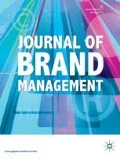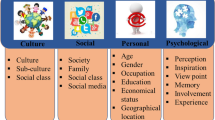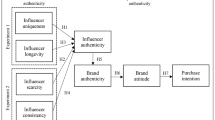Abstract
It is generally accepted that logo characteristics have significant effects on consumer brand preferences. However, little is known about how logo stability and instability drive consumer attitudes. To address this gap in the logo literature, the authors draw on a new perspective of brand concepts based on human values and explore why and how this logo characteristic exerts influence. Across three studies, the authors show that consumers prefer a stable logo brand when it embodies conservation concepts, while they prefer an unstable logo brand when it embodies openness concepts. The underlying mechanism for this matching effect is processing fluency. Furthermore, the matching effect is attenuated for people who are low (vs. high) in visual information processing. Overall, these findings shed light on when and how marketers should adopt stability/instability in logo design.




Similar content being viewed by others
Notes
Hedonism is located between openness to change and self-enhancement and thus is treated as a separate dimension.
References
Alter, A.L. 2013. The benefits of cognitive disfluency. Current Directions in Psychological Science 22 (6): 437–442.
Alter, A.L., and D.M. Oppenheimer. 2009. Uniting the tribes of fluency to form a metacognitive nation. Personality and Social Psychology Review 13 (3): 219–235.
Arnould, E.J., and C.J. Thompson. 2005. Consumer culture theory (CCT): Twenty years of research. Journal of Consumer Research 31 (4): 868–882.
Brakus, J.J., B.H. Schmitt, and L. Zarantonello. 2009. Brand experience: What is it? How is it measured? Does it affect loyalty? Journal of Marketing 73 (3): 52–68.
Cai, Y., and T. Mo. 2019. Making an exciting brand big: Brand personality, logo size and brand evaluation. Canadian Journal of Administrative Sciences 37 (3): 259–267.
Chae, B.G., and J. Hoegg. 2013. The future looks “right”: Effects of the horizontal location of advertising images on product attitude. Journal of Consumer Research 40: 223–238.
Childers, T.L., M.J. Houston, and S.E. Heckler. 1985. Measurement of individual differences in visual versus verbal information processing. Journal of Consumer Research 12 (2): 125–134.
Cholewiak, S.A., R.W. Fleming, and M. Singh. 2013. Visual perception of the physical stability of asymmetric three-dimensional objects. Journal of Vision 13 (4): 12–24.
Cian, L., A. Krishna, and R.S. Elder. 2014. This logo moves me: Dynamic imagery from static images. Journal of Marketing Research 51 (2): 18–28.
Cian, L., A. Krishna, and R.S. Elder. 2015. A sign of things to come: Behavioral change through dynamic iconography. Journal of Consumer Research 41 (April): 1426–1446.
Cleveland, M., E. Erdogan, G. Ankan, and T. Poyraz. 2011. Cosmopolitanism, individual-level values and cultural-level values: A cross-cultural study. Journal of Business Research 64 (9): 934–943.
Deng, X., and B.E. Kahn. 2009. Is your product on the right side? The “location effect” on perceived product heaviness and package evaluation. Journal of Marketing Research 46 (6): 725–738.
Doran, C.J. 2009. The role of personal values in fair trade consumption. Journal of Business Ethics 84 (4): 549–563.
Hagtvedt, H. 2011. The impact of incomplete typeface logos on perceptions of the firm. Journal of Marketing 75 (4): 86–93.
Hayes, A.F. 2012. A versatile computational tool for observed variable mediation, moderation, and conditional process modeling. Ohio: The Ohio State University.
Hayes, A.F. 2013. Introduction to mediation, moderation, and conditional process analysis: A regression-based approach. New York: Guilford Press.
He, J., H. Huang, and W. Wu. 2018. Influence of interfirm brand values congruence on relationship qualities in B2B contexts. Industrial Marketing Management 72 (July): 161–173.
Heerden, C.V., and G. Puth. 1995. Factors that determine the corporate image of South African banking institutions: An exploratory investigation. The International Journal of Bank Marketing 13 (3): 12–17.
Jiang, Y.W., G.J. Gorn, G. Maria, and C. Amitava. 2016. Does your company have the right logo? How and why circular- and angular-logo shapes influence brand attribute judgments. Journal of Consumer Research 42 (5): 709–726.
Kim, M.J., and J.H. Lim. 2019. A comprehensive review on logo literature: Research topics, findings, and future directions. Journal of Marketing Management 3: 1–75.
Labroo, A.A., and A.Y. Lee. 2006. Between two brands: A goal fluency account of brand evaluation. Journal of Marketing Research 43 (3): 374–385.
Larson, C.L., J. Aronoff, and E.L. Steuer. 2012. Simple geometric shapes are implicitly associated with affective value. Motivation and Emotion 36 (3): 404–413.
Lee, A.Y., and A. Labroo. 2004. The effect of conceptual and perceptual fluency on brand evaluation. Journal of Marketing Research 41 (5): 151–165.
Lee, J., D.H. Park, and I. Han. 2008. The effect of negative online consumer reviews on product attitude: An information processing view. Electronic Commerce Research and Applications 7 (3): 341–352.
Lieven, T., B. Grohmann, A. Herrmann, J.R. Landwehr, and M.V. Tilburg. 2015. The effect of brand design on brand gender perceptions and brand preference. European Journal of Marketing 49 (1–2): 146–169.
Luffarelli, J., A. Stamatogiannakis, and H. Yang. 2019. The visual asymmetry effect: An interplay of logo design and brand personality on brand equity. Journal of marketing research 56 (1): 89–103.
Mathwick, C., N. Malhotra, and E. Rigdon. 2001. Experiential value: Conceptualization, measurement and application in the catalog and internet shopping environment. Journal of Retailing 77 (1): 39–56.
Motyka, S., R. Suri, D. Grewal, and C. Kohli. 2016. Disfluent vs. fluent price offers: Paradoxical role of processing disfluency. Journal of the Academy of Marketing Science 44 (5): 627–638.
Pavlova, M., A.A. Sokolov, and A. Sokolov. 2005. Perceived dynamics of static images enables emotional attribution. Perception 34 (9): 1107–1116.
Peracchio, L.A., and J. Meyers-Levy. 2005. Using stylistic properties of AD pictures to communicate with consumers. Journal of Consumer Research 32 (June): 29–40.
Rahinel, R., and N.M. Nelson. 2016. When brand logos describe the environment: Design instability and the utility of safety-oriented products. Journal of Consumer Research 43 (3): 478–496.
Samuel, F., and D. Kerzel. 2011. Is this object balanced or unbalanced? Judgments are on the safe side. Journal of Experimental Psychology: Human Perception and Performance 37 (2): 529–538.
Schlosser, A.E., R.R. Rikhi, and S.W. Dagogo-Jack. 2016. The ups and downs of visual orientation: The effects of diagonal orientation on product judgment. Journal of Consumer Psychology 26 (4): 496–509.
Schwartz, S.H. 1992. Universals in the content and structure of values: Theoretical advances and empirical tests in 20 countries. Advances in Experimental Social Psychology 25: 1–65.
Schwartz, S.H., and K. Boehnke. 2004. Evaluating the structure of human values with confirmatory factor analysis. Journal of Research in Personality 38 (3): 230–255.
Schwartz, S.H., and T. Rubel. 2005. Sex differences in value priorities: Cross-cultural and multimethod studies. Journal of Personality and Social Psychology 89 (6): 1010–1028.
Shepherd, S., T.L. Chartrand, and G.J. Fitzsimons. 2015. When brands reflect our ideal world: The values and brand preferences of consumers who support versus reject society’s dominant ideology. Journal of Consumer Research 42 (1): 76–92.
Spiller, S.A., G.J. Fitzsimons, J.G. Lynch, and G.H. McClelland. 2013. Spotlights, floodlights, and the magic number zero: Simple effects tests in moderated regression. Journal of Marketing Research 50 (2): 277–288.
Steenkamp, J.B.E.M., and M.G. De Jong. 2010. A global investigation into the constellation of consumer attitudes toward global and local products. Journal of Marketing 74 (6): 18–40.
Steenkamp, J.B.E.M., R. Batra, and D.L. Alden. 2003. How perceived brand globalness creates brand value. Journal of International Business Studies 34 (1): 53–65.
Sundar, A., and T.J. Noseworthy. 2014. Place the logo high or low? Using conceptual metaphors of power in packaging design. Journal of Marketing 78 (5): 138–151.
Swaminathan, V., K.L. Page, and Z. Gürhan-canli. 2007. ‘My’ brand or ‘our’ brand: The effects of brand relationship dimensions and self-construal on brand evaluations. Journal of Consumer Research 34 (2): 248–259.
Torelli, C.J., and A.M. Kaikati. 2009. Values as predictors of judgments and behaviors: The role of abstract and concrete mindsets. Journal of Personality and Social Psychology 96 (1): 231–247.
Torelli, C.J., A. Özsomer, S.W. Carvalho, H.T. Keh, and N. Maehle. 2012. Brand concepts as representations of human values: Do cultural congruity and compatibility between values matter? Journal of Marketing 76 (4): 92–108.
Warren, C., R. Batra, S.M. Correia Loureiro, and R.P. Bagozzi. 2019. Brand coolness. Journal of Marketing 83 (5): 1–21.
Wyer, R.S., I.W. Hung, and Y. Jiang. 2008. Visual and verbal processing strategies in comprehension and judgment. Journal of Consumer Psychology 18 (4): 244–257.
Acknowledgments
This research was supported by the National Natural Science Foundation of China (Grant No. 71602111), Ministry of Education of Humanities and Social Science Project (Grant No. 20YJC630045), and Guangdong Planning Office of Philosophy and Social Science (Grant No. GD18XGL58).
Author information
Authors and Affiliations
Corresponding author
Additional information
Publisher's Note
Springer Nature remains neutral with regard to jurisdictional claims in published maps and institutional affiliations.
Appendices
Appendix A: stimuli used in Study 1

Appendix B: stimuli used in pretest 2

Appendix C: stimuli used in Study 3

Rights and permissions
About this article
Cite this article
Huang, H., Cai, Y. & Xu, L. Stability or instability: the impact of brand concepts on logo design preferences. J Brand Manag 28, 465–480 (2021). https://doi.org/10.1057/s41262-021-00238-6
Revised:
Accepted:
Published:
Issue Date:
DOI: https://doi.org/10.1057/s41262-021-00238-6




